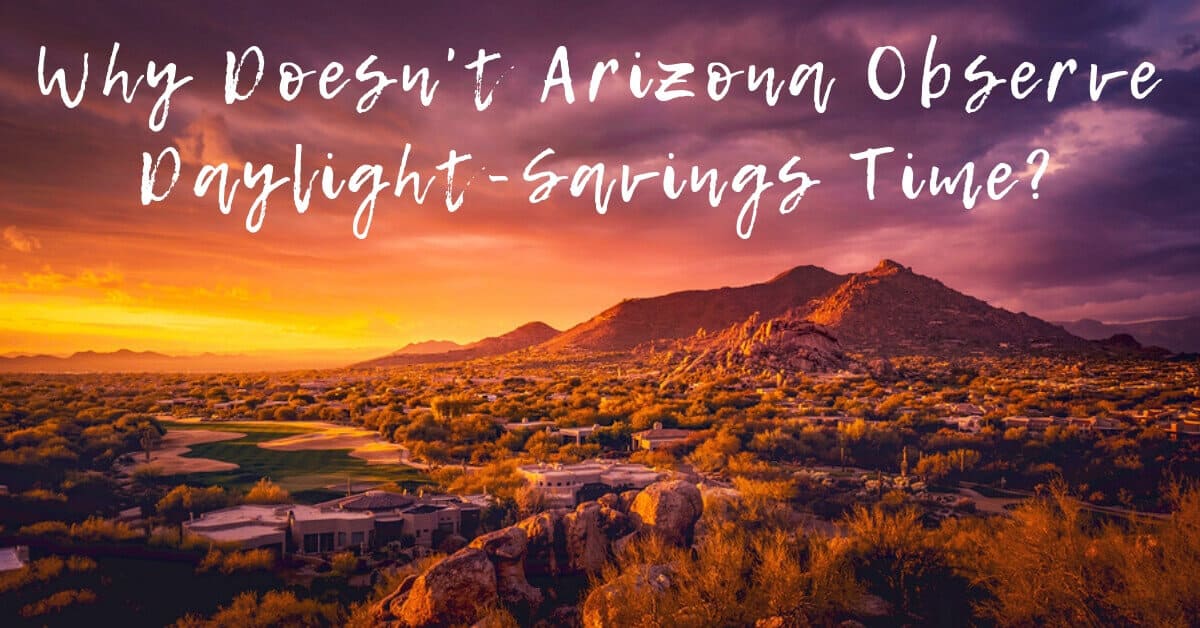- Finding the Right Indoor Plants for Desert Your Home - April 28, 2023
- Common Misunderstanding About Sun Exposure - April 18, 2023
- All about the Arizona Monsoon Season - May 21, 2021
Feels great to be back on Standard Time, doesn’t it? Oh wait – here in Arizona, we never left! While the rest of the nation time travelled last weekend to an hour in the past, Arizonans stayed the course, avoiding the kerfuffle of “falling back” only to “spring forward” six months later. This past Daylight Savings Time weekend marks the 50th anniversary of Arizona’s opting out of the time adjustment. The opt out is in effect for most of the state, excepting the Navajo Nation which does observe DST.
How did Daylight Savings Time Start?
Daylight Savings Time is a fairly new concept with a long history. While first officially practiced in parts of Canada around 1908, the enactment of DST was truly popularized in Germany in 1916, making the tradition only a little more than a century old. Around the time Daylight Savings Time was gaining traction many proposals, most of Europe went into developing the idea. Everything from gradual 20-minute time changes every week to a single 2-hour shift were floated, until the somewhat reasonable biannual one-hour shift was adopted.
While people have long held that Daylight Savings Time was based on agricultural practices, the reality is a little more industrial. Modern Daylight Savings Time was used to maximize the daylight in factories during the winter to save on lighting expenses and fuel. Before the standardization of clocks, however, most human societies operated with the sun and moon as primary measures of time. Regardless of the “hour,” people would usually wake with the sun and sleep when it set.
Does Daylight Savings Time Save Anything?
While Daylight Savings Time was initiated to save energy, recent studies into its effectiveness see the time shift as having a negligible impact on energy usage. With the gamut of modern technology and lighting, DST doesn’t significantly create a drop in electricity consumption.
Daylight Savings Time isn’t even good for your health. Any sudden change to the human circadian rhythm, even something as slight as an hour, results in a spike of accidents and injuries related to sleep changes.
Why Don’t We Do DST?
What’s the real reason why we abstain from Daylight Savings Time? In a nutshell, Arizona’s hot, sunny climate means we daylight is one thing we don’t really need to save. While folks living at more Northern latitudes feel a dramatic shift towards shortening sunshine, the Southwest sees a less pronounced change. After a long, hot Arizona summer, the cooling early twilight is a welcome reprieve.
While the Navajo Nation does observe Daylight Savings Time, the Hopi Reservation, surrounded by Navajo land, does not, creating a donut shaped area of DST within state borders. With the fall shift to Daylight Savings Time, most of Arizona is now on Mountain Time. When the rest of the country turns their clocks forward in the Spring, we’ll sync up with Pacific Standard Time and the whole state will be in the same time zone.
Not Just Arizona
Arizona and Hawaii are currently the only states not keeping Daylight Savings Time, but that has the potential to change. In the recent California election, voters opted to give the state government, rather than the federal government, control over whether or not California observes the adjustments. This means that in future state elections, Californians may vote to remove themselves from the Daylight Savings Time schedule.
Many offshore U.S. territories are also on a non-DST schedule. Puerto Rico, Guam, the U.S. Virgin Islands, American Samoa and the Mariana Islands are all operating their clocks without Daylight Savings Time. In fact, while there is wide international adoption of Daylight Savings Time, the concept is far from universal. Around the world, about 40% of nations use Daylight Savings Time while 60% do not. However, there is no international consensus on which days demarcate the start and end of Daylight Savings Time and the exact dates may differ significantly from place to place.
CC Sunscreens
Like we said before, Arizona has more than enough Daylight to spare. In fact, if you’re thinking about ways to protect your home or business from desert sun, it’s time to think about CC Sunscreens. We offer stylish, affordable customized sunscreens to keep you comfortable year-round. The best part? CC Sunscreens are an environmentally-friendly passive strategy towards year-round comfort, meaning they deliver some daylight savings you’ll notice on your energy bill. Give us a call today to find out more!

